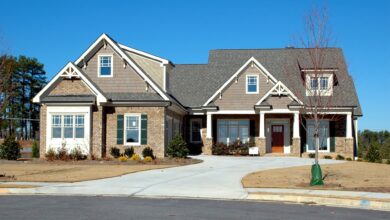7 Key Essentials for Driveway Construction
There are crucial guidelines your contractor must adhere to during installation if you want your concrete Driveway Construction to look nice for many years. The caliber of the materials and labor used to construct your driveway will significantly impact how it appears and functions over time. Use the following list as knowledge regarding proper building to ensure a driveway free of issues.
nnnn1. Concrete Placement at The Appropriate Thickness
nnnnEven more than concrete strength, concrete Driveway Construction thickness plays a significant role in determining structural capacity. Place concrete with a 4-inch minimum thickness. The cost of concrete will increase by around 20% if the thickness is increased from 4 inches to 5 inches, but the load-bearing capability of your car park construction will increase by over 50%.
nnnnConsider adding 1 or 2 inches of structural thickness to the driveway’s margins, especially where significant loads will likely be placed on them. The thicker sections should protrude 4 to 8 inches from the slab edge.
nnnnYour area’s soil and weather patterns can also call for a thicker driveway slab. Speak with a neighborhood driveway contractor for an expert recommendation.
nnnn2. Reinforcement with Rebar and Wire Mesh
nnnnYour driveway’s structural strength will increase with the addition of steel reinforcement, which is essential if the slab is subjected to heavy traffic. Although it cannot prevent fractures from happening, reinforcing can aid in keeping them held together once they have occurred.
nnnnOptions for reinforcing concrete include wire mesh and 1-inch (#4) steel rebar. Use rebar for roads of 5 inches or more; use wire mesh for car parks that are 4 to 5 inches thick. When set out in a grid pattern, the spacing between each bar should be 12 inches. Under no circumstances should the reinforcement be placed without blocks to maintain it centered within the concrete.
nnnnIt has also been demonstrated that driveways made of synthetic fibers are less prone to experience shrinkage cracks. Fibers won’t provide structural reinforcement, though.
nnnn3. Properly Constructed Subgrade
nnnnA good subgrade will give appropriate support, guarantee an even slab thickness, and guard against slab settling and structural cracking. This subgrade must be uniform in both soil composition and compaction. It is best to eliminate soft areas and replace them with sturdy materials like crushed rock or gravel. The soils are vast in several western states. Depending on the degree of expansiveness, 2 to 8 inches of crushed rock should be utilized as the subgrade material in certain circumstances. Consult a car park constructor if you are unclear about the soil properties in your location.
nnnnThe experts advise against placing concrete on a completely dry subgrade. The subgrade won’t absorb moisture from the new concrete if you spray some water on it first to dampen it.
nnnnFor subgrade compaction of residential driveways, rammers, and vibratory plate compactors are the most often employed equipment.
nnnn4. Accurately Placed Joints
nnnnFor a 4-inch-thick driveway slab, control joints should be installed with a maximum spacing of 10 feet to prevent random cracking. Random cracks can be unsightly, even though they often aren’t a structural issue and won’t shorten the driveway’s lifespan. Avoid joint arrangements that result in sections that are rectangular or triangular as well. Control joint depth is also very important. They should be manually sawing- or hand-cut to a depth equal to one-fourth of the slab (or 1 inch for a 4-inch slab) by your concrete installer.
nnnnWhere the Driveway Construction joins a sidewalk, garage floor slab, or other existing pavements, an isolation joint should be added to the control joints. Request a jointing plan from your concrete contractor as part of his written proposal.
nnnn5. Proper completion
nnnnThe two most significant mistakes made while finishing concrete driveways are overworking the surface and carrying out finishing operations when bleed water is present.
nnnnFinishing involves three steps. Your provider needs to:
nnnn- n
- To create a consistent surface, screed the concrete to level it or remove excess concrete. nnnn
- Before bleed water builds up, fill the concrete with wood or magnesium. nnnn
- If plans call for stamping the driveway or applying any attractive textured finish (see Making Concrete Slip Resistant), just sweep the surface to increase traction. n
Final finishing with a steel trowel is not required and may even be detrimental, as it will seal the concrete surface too soon and stop the water from evaporating.
nnnn6. Drainage
nnnnThe concrete contractors advise that your driveway slope at least 1/8 inch per foot towards the street and away from existing structures (such as your house and garage) to minimize standing water. Installing a drain that will collect the water at a low place in the concrete and direct it away may be necessary if adequate drainage is impeded by the concrete slab being squeezed between two structures.
nnnn7. Curing Methods
nnnnProfessionals from the asphalt company recommend curing the concrete as soon as the finishing is complete. The concrete must be cured as the final and most crucial phase. Regrettably, it’s also one of the least maintained. By decreasing the concrete’s resilience to weathering and raising the likelihood of surface flaws, delaying curing the concrete after final finishing can, in extreme situations, lead to strength decreases of up to 50%.
nnnnIn addition to utilizing a healing chemical, there are other ways to cure concrete. The best procedure for slabs that will be acid stained is wet curing since acid stain penetration requires the elimination of a curing chemical. However, the most common way to cure plain or integrally colored concrete is by utilizing a liquid curing solution.
nnnnRoad seal Civil: Your Best Driveway Constructors
nnnnA complex task, driveway construction involves meticulous planning, attention to detail, and adherence to fundamental principles. These elements are crucial in building a long-lasting and valuable driveway, from picking the appropriate materials and drainage options to ensuring correct grading and upkeep. The project’s success depends on how well these components work together to protect your investment and offer a secure and attractive entry to your property. Recognizing and taking care of these necessities improves curb appeal while extending your home’s life and value.
n


